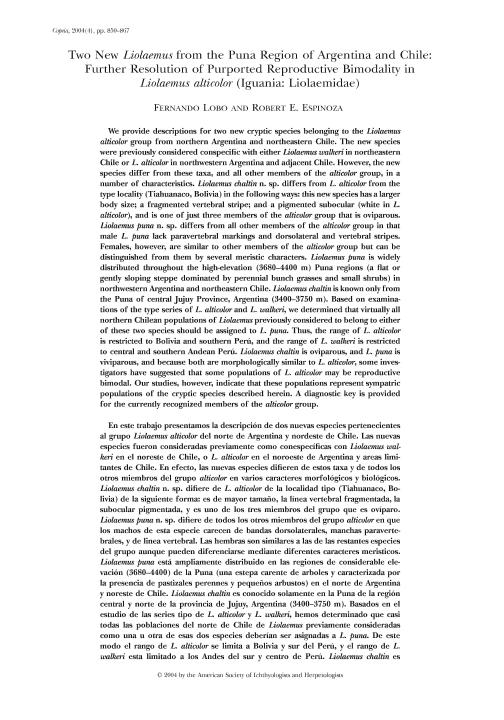Mostrar el registro sencillo del ítem
dc.contributor.author
Lobo Gaviola, Fernando Jose

dc.contributor.author
Espinoza, Robert

dc.date.available
2018-08-03T21:32:41Z
dc.date.issued
2004-12
dc.identifier.citation
Lobo Gaviola, Fernando Jose; Espinoza, Robert; Two new Liolaemus from the Puna Region of Argentina and Chile: Further resolution of purported reproductive bimodality in Liolaemus alticolor (Iguania: Liolaemidae); American Society of Ichthyologists and Herpetologists; Copeia; 4; 12-2004; 850-867
dc.identifier.issn
0045-8511
dc.identifier.uri
http://hdl.handle.net/11336/54202
dc.description.abstract
We provide descriptions for two new cryptic species belonging to the Liolaemus alticolor group from northern Argentina and northeastern Chile. The new species were previously considered conspecific with either Liolaemus walkeri in northeastern Chile or L. alticolor in northwestern Argentina and adjacent Chile. However, the new species differ from these taxa, and all other members of the alticolor group, in a number of characteristics. Liolaemus chaltin n. sp. differs from L. alticolor from the type locality (Tiahuanaco, Bolivia) in the following ways: this new species has a larger body size; a fragmented vertebral stripe; and a pigmented subocular (white in L. alticolor), and is one of just three members of the alticolor group that is oviparous. Liolaemus puna n. sp. differs from all other members of the alticolor group in that male L. puna lack paravertebral markings and dorsolateral and vertebral stripes. Females, however, are similar to other members of the alticolor group but can be distinguished from them by several meristic characters. Liolaemus puna is widely distributed throughout the high-elevation (3680-4400 m) Puna regions (a flat or gently sloping steppe dominated by perennial bunch grasses and small shrubs) in northwestern Argentina and northeastern Chile. Liolaemus chaltin is known only from the Puna of central Jujuy Province, Argentina (3400-3750 m). Based on examinations of the type series of L. alticolor and L. walkeri, we determined that virtually all northern Chilean populations of Liolaemus previously considered to belong to either of these two species should be assigned to L. puna. Thus, the range of L. alticolor is restricted to Bolivia and southern Perú, and the range of L. walkeri is restricted to central and southern Andean Perú. Liolaemus chaltin is oviparous, and L. puna is viviparous, and because both are morphologically similar to L. alticolor, some investigators have suggested that some populations of L. alticolor may be reproductive bimodal. Our studies, however, indicate that these populations represent sympatric populations of the cryptic species described herein. A diagnostic key is provided for the currently recognized members of the alticolor group.
dc.format
application/pdf
dc.language.iso
eng
dc.publisher
American Society of Ichthyologists and Herpetologists

dc.rights
info:eu-repo/semantics/openAccess
dc.rights.uri
https://creativecommons.org/licenses/by-nc-sa/2.5/ar/
dc.subject
Liolaemus
dc.subject
Alticolor
dc.subject
Bimodality
dc.subject
Species
dc.subject.classification
Otras Ciencias Biológicas

dc.subject.classification
Ciencias Biológicas

dc.subject.classification
CIENCIAS NATURALES Y EXACTAS

dc.title
Two new Liolaemus from the Puna Region of Argentina and Chile: Further resolution of purported reproductive bimodality in Liolaemus alticolor (Iguania: Liolaemidae)
dc.type
info:eu-repo/semantics/article
dc.type
info:ar-repo/semantics/artículo
dc.type
info:eu-repo/semantics/publishedVersion
dc.date.updated
2018-08-03T15:21:07Z
dc.identifier.eissn
1938-5110
dc.journal.number
4
dc.journal.pagination
850-867
dc.journal.pais
Estados Unidos

dc.journal.ciudad
Lawrence
dc.description.fil
Fil: Lobo Gaviola, Fernando Jose. Consejo Nacional de Investigaciones Científicas y Técnicas. Centro Científico Tecnológico Conicet - Salta. Instituto de Bio y Geociencias del NOA. Universidad Nacional de Salta. Facultad de Ciencias Naturales. Museo de Ciencias Naturales. Instituto de Bio y Geociencias del NOA; Argentina
dc.description.fil
Fil: Espinoza, Robert. Universidad Nacional de Salta; Argentina
dc.journal.title
Copeia

dc.relation.alternativeid
info:eu-repo/semantics/altIdentifier/doi/https://doi.org/10.1643/CH-03-241R1
dc.relation.alternativeid
info:eu-repo/semantics/altIdentifier/url/http://www.bioone.org/doi/abs/10.1643/CH-03-241R1
Archivos asociados
